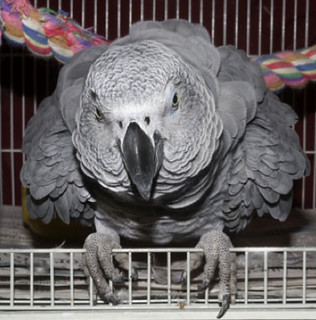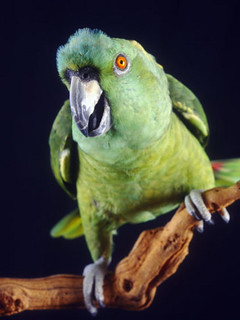Parrot biting, body language and preventing the bite
 Friday, May 18, 2012 at 8:05
Friday, May 18, 2012 at 8:05  Ouch? Christine with her Blue and Gold free flighted macaws.The parrot beak; formidable, powerful, dangerous, wondrous. And it hurts like crazy when it pierces our skin. Just why do parrots bite? In the words of Susan Friedman, Ph.D, “Most biting, regardless of situation, is to remove intruding hands that cannot be removed any other way. Birds learn to bite to communicate 'no' because we don’t listen to lesser communications of 'no'.” I try to explain to people that every animal has a right to say 'no', so, if you don’t want them saying 'no' with a bite, what behavior are you willing to take?”
Ouch? Christine with her Blue and Gold free flighted macaws.The parrot beak; formidable, powerful, dangerous, wondrous. And it hurts like crazy when it pierces our skin. Just why do parrots bite? In the words of Susan Friedman, Ph.D, “Most biting, regardless of situation, is to remove intruding hands that cannot be removed any other way. Birds learn to bite to communicate 'no' because we don’t listen to lesser communications of 'no'.” I try to explain to people that every animal has a right to say 'no', so, if you don’t want them saying 'no' with a bite, what behavior are you willing to take?”
What we want to learn in this article is how to prevent the bite, but first we need to know what an impending bite might look like. Please look at the slide show to see reference images.
 African grey parrot whose body language of being fluffed up, hunkered over and head down is saying 'no' to any attempt to pick him up or touch him. Bonnie JayAfrican grey. Here we have a fluffed-up, aggressively postured creature who will bite any fingers that come within striking distance, even if they pass by accidentally. The reason for this posture may not be clear, but we must honor it nevertheless. No one wants to indulge this bird's readiness to bite so we will not force any fingers or hands upon him until those feathers go down, and then we will be very careful what we choose to do next.
African grey parrot whose body language of being fluffed up, hunkered over and head down is saying 'no' to any attempt to pick him up or touch him. Bonnie JayAfrican grey. Here we have a fluffed-up, aggressively postured creature who will bite any fingers that come within striking distance, even if they pass by accidentally. The reason for this posture may not be clear, but we must honor it nevertheless. No one wants to indulge this bird's readiness to bite so we will not force any fingers or hands upon him until those feathers go down, and then we will be very careful what we choose to do next.





